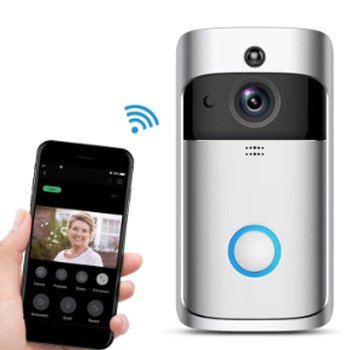Description
A Doorbell Camera is a smart device that combines a traditional doorbell with a built-in camera, microphone, and speaker. This allows homeowners to see, hear, and communicate with visitors at their door through a mobile app, even when they are not at home. Doorbell cameras are popular for enhancing home security and convenience.
Key Features of a Doorbell Camera:
Live Video Streaming:
Real-Time Viewing: Doorbell cameras provide live video feeds that can be accessed through a smartphone, tablet, or computer. This allows you to see who is at your door in real-time.
High-Definition Video: Most doorbell cameras offer HD resolution, typically 1080p, ensuring clear and detailed video, which is especially important for recognizing faces and other details.
Two-Way Audio:
Communication: Doorbell cameras are equipped with a microphone and speaker, allowing you to talk to visitors through your mobile device. This feature is useful for giving instructions to delivery personnel, greeting guests, or deterring potential intruders.
Motion Detection and Alerts:
Instant Notifications: The camera can send push notifications to your phone when it detects motion at your door. This feature helps you stay informed of any activity, whether it’s a visitor, a delivery, or something suspicious.
Customizable Zones: Some doorbell cameras allow you to set specific motion detection zones to focus on areas like the doorstep or driveway, reducing false alarms from passing cars or pedestrians.
Night Vision:
Infrared LEDs: Doorbell cameras typically include infrared night vision capabilities, allowing you to see clearly in low-light or dark conditions. This ensures that the camera remains effective at night.
Video Recording and Storage:
Cloud Storage: Many doorbell cameras offer cloud storage for recorded video clips, allowing you to access and review footage from anywhere. Some providers offer subscription plans for extended storage and additional features.
Local Storage: Some models offer local storage options, such as a microSD card slot, allowing you to save video locally without a subscription.
Wide Field of View:
Coverage: Doorbell cameras often feature wide-angle lenses to capture a broad view of the area in front of your door. Some models offer 180-degree views, minimizing blind spots.
Smart Home Integration:
Compatibility: Doorbell cameras can integrate with smart home systems like Amazon Alexa, Google Assistant, or Apple HomeKit. This allows you to control the camera using voice commands, view the feed on smart displays, and integrate it with other smart devices.
Chime Integration: Some doorbell cameras can be connected to your home’s existing doorbell chime or come with a wireless chime for indoor alerts.
Mobile App Control:
App Features: Through a mobile app, you can control all aspects of the doorbell camera, such as viewing live video, talking to visitors, adjusting settings, and reviewing recorded footage.
Power Options:
Battery-Powered: Some doorbell cameras are battery-powered, offering flexibility in installation. These typically require periodic recharging.
Wired: Other models are hardwired to your existing doorbell wiring, providing continuous power without the need for battery changes.
Durability and Weatherproofing:
Outdoor Use: Doorbell cameras are designed to withstand outdoor conditions, including rain, heat, and cold. They are typically weatherproof with an IP rating indicating their level of protection.
Applications of a Doorbell Camera:
Home Security: Monitor your front door to deter burglars, package thieves, and other intruders.
Visitor Management: See who is at your door before answering, and communicate with visitors remotely.
Package Delivery Monitoring: Keep track of deliveries, ensuring that packages are not stolen or left in an inappropriate spot.
Convenience: Answer your door from anywhere, whether you’re in another room or away from home.
Considerations When Choosing a Doorbell Camera:
Video Quality: Higher resolution provides clearer images, which can be crucial for identifying visitors or capturing important details.
Motion Detection Sensitivity: Choose a model with customizable motion detection settings to minimize false alerts.
Power Source: Decide whether you prefer a battery-powered model for easy installation or a wired model for continuous power.
Storage Options: Consider whether you want to use cloud storage, local storage, or a combination of both, and be aware of any associated subscription fees.
Field of View: Ensure the camera’s field of view covers the area you want to monitor, especially if you have a wide porch or front yard.
Smart Home Integration: Check if the doorbell camera is compatible with your existing smart home ecosystem if you want integrated functionality.
Would you like recommendations for specific doorbell camera models or further assistance with setup?






Reviews
There are no reviews yet.